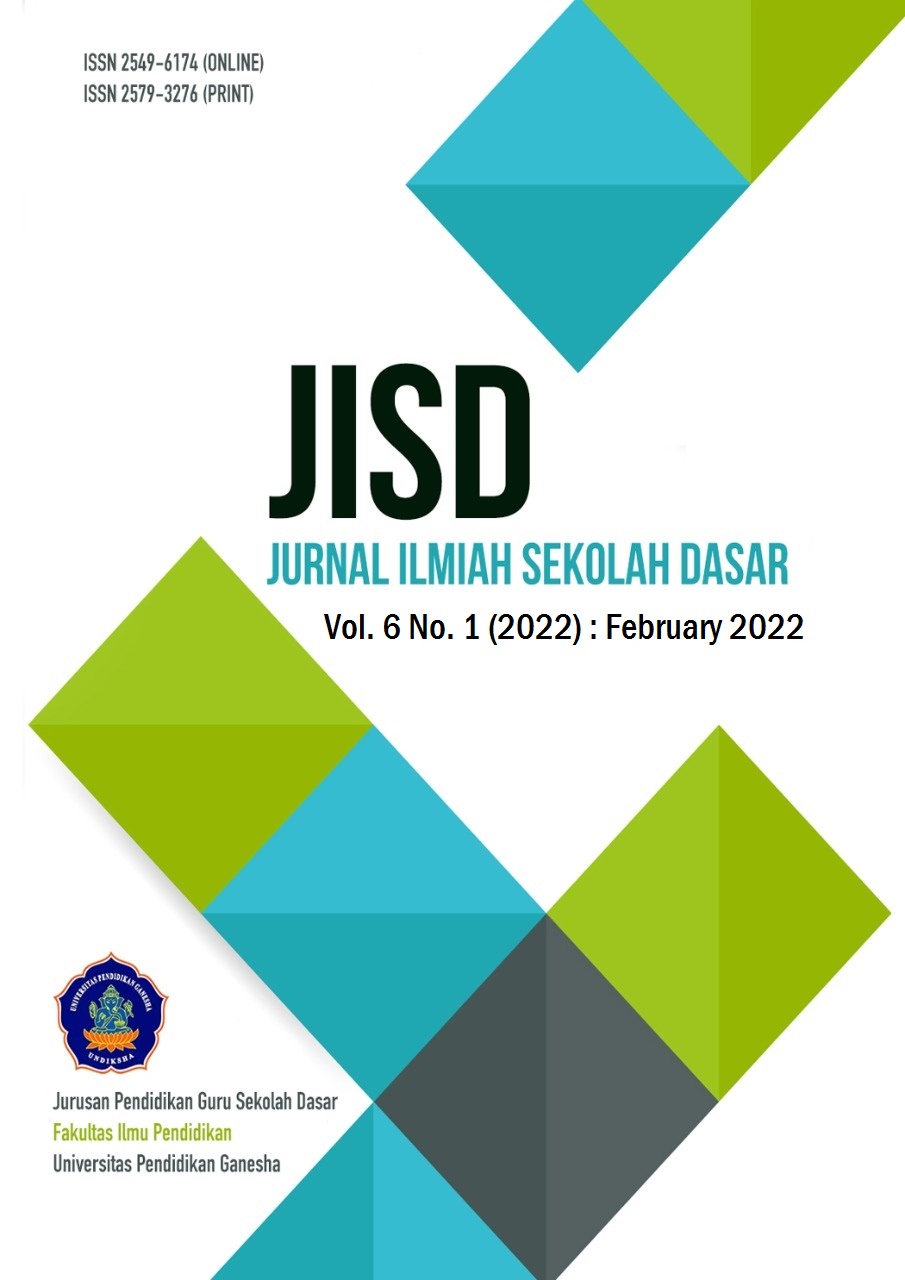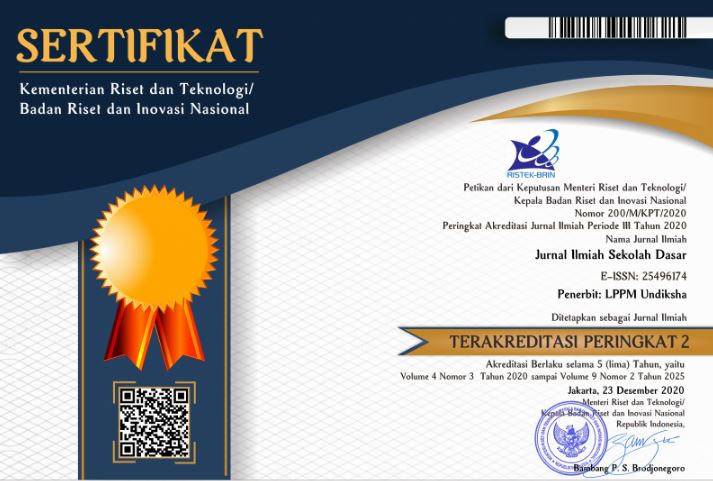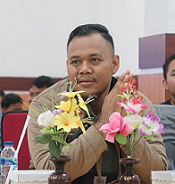Evaluation of Online Learning During the Covid 19 Pandemic
DOI:
https://doi.org/10.23887/jisd.v6i1.42113Keywords:
Online Learning, Evaluation, CIPPAbstract
Learning that is usually done face-to-face has turned into virtual face-to-face learning. This certainly raises various problems, including theaspect context concerning government policies in the field of education, theaspect input relating to online learning supporting infrastructure, the process aspect concerning the readiness of educators to conduct online learning, and theaspect product relating to student learning outcomes. Therefore, this research is very urgent to find out whether or not the implementation of online learning from the previously mentioned CIPP component is effective. It is important to do this as an evaluation material that the government can do regarding learning during the covid 19 pandemic. This research is an evaluation study using the CIPP (Context, Input, Process, Product) evaluation model. The subjects studied in this study were 698 people from the total population of 3,334. The method of data collection in this study, using the non-test method by distributing closed questionnaires. Data were analyzed using quantitative descriptive statistics, then converted into Z scores and transformed into T scores. Based on the data analysis, the results showed that the components of the context variable were effective, the input variables were less effective, the process variables were effective and the product variables were effective, so it can be concluded that the implementation of online learning is in quadrant II (second) or quite effective. Recommendations for further research are that it is necessary to improve indicators that have not been running well/effectively and to find solutions to various obstacles in online learning, so that the quality of online learning increases.
References
Abdel-Hameed, F. S. M., Tomczyk, Ł., & Hu, C. (2021). The editorial of special issue on education, IT, and the COVID-19 pandemic. Education and Information Technologies, 26(6). https://doi.org/10.1007/s10639-021-10781-z. DOI: https://doi.org/10.1007/s10639-021-10781-z
Alan, Ü. (2021). Distance Education During the COVID-19 Pandemic in Turkey: Identifying the Needs of Early Childhood Educators. Early Childhood Education Journal, 49(5). https://doi.org/10.1007/s10643-021-01197-y. DOI: https://doi.org/10.1007/s10643-021-01197-y
Ali, M. K., & Maksum, H. (2020). Utilization of E-Learning-Based ICT Learning Using the Google Classroom Application During the COVID-19 Pandemic. Journal of Education Research and Evaluation, 4(4), 373. https://doi.org/10.23887/jere.v4i4.29181. DOI: https://doi.org/10.23887/jere.v4i4.29181
Alimin, F. G., & Saad, M. S. M. (2019). The Effectiveness of Google Classroom as an Instructional Media: A Case of State Islamic Institute of Kendari, Indonesia. Journal of Humanities and Social Sciences, 7(2). https://doi.org/10/18510/hssr.2019.7227. DOI: https://doi.org/10.18510/hssr.2019.7227
Arizona, K., Abidin, Z., & Rumansyah, R. (2020). Pembelajaran Online Berbasis Proyek Salah Satu Solusi Kegiatan Belajar Mengajar Di Tengah Pandemi Covid-19. Jurnal Ilmiah Profesi Pendidikan, 5(1). https://doi.org/10.29303/jipp.v5i1.111. DOI: https://doi.org/10.29303/jipp.v5i1.111
Arkiang, F. (2021). Analisis Pembelajaran Daring Selama Pandemi Covid-19 Di Daerah 3T (Nusa Tenggara Timur). Jurnal Pendidikan, 12(1), 57–64. https://doi.org/10.31258/jp.12.1.57-64. DOI: https://doi.org/10.52005/belaindika.v3i2.70
Badriyah, I. R., Akhwani, A., Nafiah, N., & Djazilan, M. S. (2021). Analisis Model Pembelajaran Daring dan Luring pada Masa Pandemi Covid-19 di Sekolah Dasar. Jurnal Basicedu, 5(5). https://doi.org/10.31004/basicedu.v5i5.1373. DOI: https://doi.org/10.31004/basicedu.v5i5.1373
Bervell, B., Nyagorme, P., & Arkorful, V. (2020). LMS-Enabled Blended Learning Use Intentions among Distance Education Tutors: Examining the Mediation Role of Attitude Based on Technology-Related Stimulus-Response Theoretical Framework (TR-SR-TF). Contemporary Educational Technology, 12(2), ep273. https://doi.org/10.30935/cedtech/8317. DOI: https://doi.org/10.30935/cedtech/8317
Bhakti, Y. B. (2017). Evaluasi Program Model CIPP Pada Proses Pembelajaran IPA. JIPFRI: Jurnal Inovasi Pendidikan Fisika Dan Riset Ilmiah, 1(2). https://doi.org/10.30599/jipfri.v1i2.109. DOI: https://doi.org/10.30599/jipfri.v1i2.109
Buana, D. R. (2020). Analisis Perilaku Masyarakat Indonesia dalam Menghadapi Pandemi Virus Corona (Covid-19) dan Kiat Menjaga Kesejahteraan Jiwa. SALAM: Jurnal Sosial Dan Budaya Syar-I, 7(3). https://doi.org/10.15408/sjsbs.v7i3.15082. DOI: https://doi.org/10.15408/sjsbs.v7i3.15082
Djamdjuri, S., Dewi, & Kamilah, A. (2020). Whatsapp Media in Online Learning During Covid-19 Pandemic. English Journal, 14(2), 69. https://doi.org/10.32832/english.v14i2.3792. DOI: https://doi.org/10.32832/english.v14i2.3792
El-Sayad, G., Md Saad, N. H., & Thurasamy, R. (2021). How higher education students in Egypt perceived online learning engagement and satisfaction during the COVID-19 pandemic. Journal of Computers in Education, 8(4). https://doi.org/10.1007/s40692-021-00191-y. DOI: https://doi.org/10.1007/s40692-021-00191-y
Fitriya, D., Magdalena, I., & Fauziah Fadhillahwati, N. (2021). Konsep Pembelajaran Daring di Era Pandemi Covid-19. Cerdika: Jurnal Ilmiah Indonesia, 1(3), 182–188. https://doi.org/10.36418/cerdika.v1i3.30. DOI: https://doi.org/10.36418/cerdika.v1i3.30
Garad, A., Al-Ansi, A. M., & Qamari, I. N. (2021). The Role Of E-Learning Infrastructure And Cognitive Competence In Distance Learning Effectiveness During The Covid-19 Pandemic. Cakrawala Pendidikan, 40(1). https://doi.org/10.21831/cp.v40i1.33474. DOI: https://doi.org/10.21831/cp.v40i1.33474
Guswara, A. M. (2020). The Contribution of Google Classroom Application and Motivation to The Learning Outcomes of Web Programming. Educational Technology, 4(4), 1–9. https://doi.org/10.23887/jet.v4i4.29896. DOI: https://doi.org/10.23887/jet.v4i4.29896
Haka, N. B., Anggita, L., Anggoro, B. S., & Hamid, A. (2020). Pengaruh Blended Learning Berbantukan Google Classroom Terhadap Keterampilan Berpikir Kreatif Dan Kemandirian Belajar Peserta Didik. Edu Sains Jurnal Pendidikan Sains & Matematika. https://doi.org/10.23971/eds.v8i1.1806. DOI: https://doi.org/10.23971/eds.v8i1.1806
Handayani, R., Arif, M., & Syam, A. (2020). Pembelajaran Daring Pada Anak Usia Sekolah Dasar Masa Pendemi Covid-19 Di Kecamatan Pauh. Kepemimpinan Dan Kepengurusan Sekolah, 5(2), 107–114. https://doi.org/10.34125/kp.v5i2.516. DOI: https://doi.org/10.34125/kp.v5i2.516
Hanik, E. U. (2020). Self directed learning berbasis literasi digital pada masa pandemi covid-19 di Madrasah Ibtidaiyah. ELEMENTARY: Islamic Teacher Journal, 8(1), 183. https://doi.org/10.21043/elementary.v8i1.7417. DOI: https://doi.org/10.21043/elementary.v8i1.7417
Hapsari, T. P. R. N., & Fitria, A. S. (2020). Efektivitas Pembelajaran Daring Mata Kuliah Evaluasi Pengajaran Bahasa Dan Sastra Indonesia Masa Pandemi Covid-19. Jurnal Ilmiah SEMANTIKA, 2(01), 11–20. https://doi.org/10.46772/semantika.v2i01.259. DOI: https://doi.org/10.46772/semantika.v2i01.259
Hidayati, A. N., Dewi, N. S. N., Nurhaedin, E., & Rosmala, D. (2020). The Effect of Google Classroom in Blended Learning on University Students English Ability. J-SHMIC : Journal of English for Academic, 7(1), 66–76. https://doi.org/10.25299/jshmic.2021.vol8(1).6216. DOI: https://doi.org/10.25299/jshmic.2021.vol8(1).6216
Hoyles, C. A., Noss, R., Vahey, P., & Roschelle, J. (2013). Cornerstone Mathematics: Designing digital technology for teacher adaptation and scaling. ZDM - International Journal on Mathematics Education, 45(7), 1057–1070. https://doi.org/10.1007/s11858-013-0540-4. DOI: https://doi.org/10.1007/s11858-013-0540-4
Hutauruk, A., & Sidabutar, R. (2020). Kendala pembelajaran daring selama masa pandemi di kalangan mahasiswa pendidikan matematika: Kajian kualiatatif deskriptif. Journal of Mathematics Education and Applied, 02(01), 45–51. https://doi.org/10.36655/sepren.v2i1.364. DOI: https://doi.org/10.36655/sepren.v2i1.364
Jiang, H., Islam, A. Y. M. A., & Gu, X. et al. (2021). Online learning satisfaction in higher education during the COVID-19 pandemic: A regional comparison between Eastern and Western Chinese universities. Educ Inf Technol, 1(1). https://doi.org/10.1007/s10639-021-10519-x. DOI: https://doi.org/10.1007/s10639-021-10519-x
Junanto, S., & Kusna, N. A. A. (2018). Evaluasi Program Pembelajaran di PAUD Inklusi dengan Model Context, Input, Process, and Product (CIPP). Journal of Disability Studies Inklusi, 2(2). https://doi.org/10.14421/ijds.050202. DOI: https://doi.org/10.14421/ijds.050202
Kantun, S. (2017). Penelitian Evaluatif Sebagai Salah Satu Model Penelitian Dalam Bidang Pendidikan. Majalah Ilmiah Dinamika, 37(1).
Karadag, E., Su, A., & Ergin-Kocaturk, H. (2021). Multi-level analyses of distance education capacity, faculty members’ adaptation, and indicators of student satisfaction in higher education during COVID-19 pandemic. International Journal of Educational Technology in Higher Education, 18(1). https://doi.org/10.1186/s41239-021-00291-w. DOI: https://doi.org/10.1186/s41239-021-00291-w
Khurriyati, Y., Setiawan, F., & Mirnawati, L. B. (2021). Dampak Pembelajaran Daring Terhadap Hasil Belajar Siswa Mi Muhammadiyah 5 Surabaya. Jurnal Ilmiah Pendidikan Dasar, 8(1), 91. https://doi.org/10.30659/pendas.8.1.91-104. DOI: https://doi.org/10.30659/pendas.8.1.91-104
Kolhar, M., Kazi, R. N. A., & Alameen, A. (2021). Effect of social media use on learning, social interactions, and sleep duration among university students. Saudi Journal of Biological Sciences, 28(4), 2216–2222. https://doi.org/10.1016/J.SJBS.2021.01.010. DOI: https://doi.org/10.1016/j.sjbs.2021.01.010
Kumar, J. A., Bervell, B., & Osman, S. (2020). Google classroom : insights from Malaysian higher education students ’ and instructors ’ experiences. Education and Information Technologies, 25. https://doi.org/10.1007/s10639-020-10163-x. DOI: https://doi.org/10.1007/s10639-020-10163-x
Kurniawati, & Hariwibowo, P. (2014). Evaluasi Program Pelatihan Product Knowledge Departemen Marketing Delta Pada PT Phapros Tbk Semarang. Admisi Dan Bisnis, 15(1), 11–22. https://doi.org/10.32497/ab.v15i1.1010.
Kurniawati, M., Santanapurba, H., & Kusumawati, E. (2019). Penerapan Blended Learning Menggunakan Model Flipped Classroom Berbantuan Google Classroom Dalam Pembelajaran Matematika Smp. EDU-MAT: Jurnal Pendidikan Matematika, 7(1), 8–19. https://doi.org/10.20527/edumat.v7i1.6827. DOI: https://doi.org/10.20527/edumat.v7i1.6827
Laksana, D. N. L. (2020). Implementation of Online Learning in The Pandemic Covid-19: Student Perception in Areas with Minimum Internet Access. Journal of Education Technology, 4(4), 509–509. https://doi.org/10.23887/jet.v4i4.29314. DOI: https://doi.org/10.23887/jet.v4i4.29314
Lapada, A. A., Miguel, F. F., Robledo, D. A. R., & Alam, Z. F. (2020). Teachers’ Covid-19 Awareness, Distance Learning Education Experiences and Perceptions towards Institutional Readiness and Challenges. International Journal of Learning, Teaching and Educational Research, 19(6), 127–144. https://doi.org/10.26803/ijlter.19.6.8. DOI: https://doi.org/10.26803/ijlter.19.6.8
Lase, D., Zega, T. G. C., & Daeli, D. O. (2021). Parents’ Perceptions of Distance Learning during COVID-19 Pandemic in Rural Indonesia. SSRN Electronic Journal, 13(2), 101–111. https://doi.org/10.2139/ssrn.3890610. DOI: https://doi.org/10.2139/ssrn.3890610
Lau, E. Y. H., & Lee, K. (2021). Parents’ Views on Young Children’s Distance Learning and Screen Time During COVID-19 Class Suspension in Hong Kong. Early Education and Development, 32(6), 863–880. https://doi.org/10.1080/10409289.2020.1843925. DOI: https://doi.org/10.1080/10409289.2020.1843925
Lim, M. T. C., Ramamurthy, M. B., Aishworiya, R., Rajgor, D. D., Tran, A. P., Hiriyur, P., Kunaseelan, S., Jabri, M., & Goh, D. Y. T. (2021). School closure during the coronavirus disease 2019 (COVID-19) pandemic – Impact on children’s sleep. Sleep Medicine, 78(January 2020), 108–114. https://doi.org/10.1016/j.sleep.2020.12.025. DOI: https://doi.org/10.1016/j.sleep.2020.12.025
Lukum, A. (2015). Evaluasi Program Pembelajaran Ipa Smp Menggunakan Model Countenance Stake. Jurnal Penelitian Dan Evaluasi Pendidikan, 19(1), 25–37. https://doi.org/10.21831/pep.v19i1.4552. DOI: https://doi.org/10.21831/pep.v19i1.4552
Maharani, N., & Kartini, K. S. (2019). Penggunaan google classroom sebagai pengembangan kelas virtual dalam keterampilan pemecahan masalah topik kinematika pada mahasiswa jurusan sistem komputer. PENDIPA Journal of Science Education, 3(3), 167–173. https://doi.org/10.33369/pendipa.3.3.167-173. DOI: https://doi.org/10.33369/pendipa.3.3.167-173
Mahitsa, M., & Mahardini, A. (2020). Analisis Situasi Penggunaan Google Classroom pada Pembelajaran Daring Fisika. Jurnal Pendidikan FIsika, VIII(2), 215–224. https://doi.org/10.24127/jpf.v8i2.3102 ANALISIS. DOI: https://doi.org/10.24127/jpf.v8i2.3102
Mansur, H., Jumadi, Mastur, Utama, A. H., & Prastitasari, H. (2021). The Problem of Distance Learning During the Covid-19 Pandemic. Ilkogretim Online - Elementary Education Online, 20(4), 168–175. https://doi.org/10.17051/ilkonline.2021.04.19.
Maulana, H. A. &, & Iswari, R. D. (2020). Analisis Tingkat Stres Mahasiswa Terhadap Pembelajaran Daring Pada Mata Kuliah Statistik Bisnis di Pendidikan Vokasi. Jurnal Ilmiah Kependidikan, 14(1), 17–30. https://doi.org/10.30595/jkp.v14i1.8479. DOI: https://doi.org/10.30595/jkp.v14i1.8479
Meşe, E., & Sevilen, Ç. (2021). Factors influencing EFL students’ motivation in online learning: A qualitative case study. Journal of Educational Technology & Online Learning, 4(1), 11–22. https://doi.org/10.31681/ jetol.817680.
Nurhayati, Y. (2018). Penerapan Model Kirkpatrick untuk Evaluasi Program Diklat Teknis Subtantif Materi Perencanaan Pembelajaran Di Wilayah Kerja Provinsi Kepulauan Riau. Andragogi: Jurnal Diklat Teknis Pendidikan Dan Keagamaan, 6(2), 170–187. https://doi.org/10.36052/andragogi.v6i2.63. DOI: https://doi.org/10.36052/andragogi.v6i2.63
Nurkholis, I. (2021). Analisis Kelebihan dan Kekurangan dalam Pembelajaran Daring di SDN Pesanggrahan 01 Kota Batu Malang. PTK: Jurnal Tindakan Kelas, 2(1), 84–89. https://doi.org/10.53624/ptk.v2i1.45. DOI: https://doi.org/10.53624/ptk.v2i1.45
Pan, G., Shankararaman, V., Koh, K., & Gan, S. (2021). Students’ evaluation of teaching in the project-based learning programme: An instrument and a development process. The International Journal of Management Education, 19(2). https://doi.org/10.1016/j.ijme.2021.100501. DOI: https://doi.org/10.1016/j.ijme.2021.100501
Paramita, R., Ganda, R., Panjaitan, P., Ariyati, E., & Paramita, R. (2018). Pengembangan Booklet Hasil Inventarisasi Tumbuhan Obat Sebagai Media Pembelajaran Pada Materi Manfaat Keanekaragaman Hayati. Jurnal IPA & Pembelajaran IPA, 02(02). https://doi.org/10.24815/jipi.v2i2.12389. DOI: https://doi.org/10.24815/jipi.v2i2.12389
Parmin, Sajidan, Ashadi, & Sutikno. (2015). Skill of prospective teacher in integrating the concept of science with local wisdom model. Jurnal Pendidikan IPA Indonesia, 4(2), 120–126. https://doi.org/10.15294/jpii.v4i2.4179.
Permata, A., & Bhakti, Y. B. (2020). Keefektifan Virtual Class dengan Google Classroom dalam Pembelajaran Fisika Dimasa Pandemi Covid-19. JIPFRI (Jurnal Inovasi Pendidikan Fisika Dan Riset Ilmiah), 4(1), 27–33. https://doi.org/10.30599/jipfri.v4i1.669. DOI: https://doi.org/10.30599/jipfri.v4i1.669
Prawiyogi, A. G., Purwanugraha, A., Fakhry, G., & Firmansyah, M. (2020). Efektifitas Pembelajaran Jarak Jauh Terhadap Pembelajaran Peserta didik di SDIT Purwakarta. JPD: Jurnal Pendidikan Dasar, 11(1). https://doi.org/10.21009/10.21009/JPD.081. DOI: https://doi.org/10.21009/10.21009/JPD.081
Priatmoko, S., Sugiri, W. A., Bashori, & Islamy, M. I. (2021). Distance Learning for New Students in the Era of Pandemic Coronavirus Disease (Covid-19): Implementation and Barriers. Proceedings of the International Conference on Engineering, Technology and Social Science (ICONETOS 2020), 529(Iconetos 2020), 607–613. https://doi.org/10.2991/assehr.k.210421.088. DOI: https://doi.org/10.2991/assehr.k.210421.088
Primasari, I. F. N. D., & Zulela. (2021). Kendala Pembelajaran Jarak Jauh (PJJ) Secara Online Selama Masa Pandemik Covid-19 di Sekolah Dasar. JIKAP PGSD: Jurnal Ilmiah Ilmu Kependidikan, 5(1), 64–73. https://doi.org/10.26858/jkp.v5i1.16820. DOI: https://doi.org/10.26858/jkp.v5i1.16820
Pujiasih, E. (2020). Membangun Generasi Emas Dengan Variasi Pembelajaran Online Di Masa Pandemi Covid-19. Ideguru: Jurnal Karya Ilmiah Guru, 5(1), 42–48. https://doi.org/10.51169/ideguru.v5i1.136. DOI: https://doi.org/10.51169/ideguru.v5i1.136
Putri, V. D. (2020). Layanan Bimbingan dan Konseling Daring Selama Masa Pandemi COVID-19. Jurnal Bimbingan Konseling Pendidikan Islam, 1(2), 7–16. https://doi.org/10.47453/coution.v1i2.95. DOI: https://doi.org/10.47453/coution.v1i2.95
Rahmawati, D., & Anggraini, A. D. (2017). Evaluasi Program Kurikulum Berdasarkan Standar Isi, Standar Proses, Dan Standar Kompetensi Lulusan Di Sdn Pisangan Timur 10 Pagi. Jurnal Pendidikan Ekonomi Dan Bisnis (JPEB), 5(1), 34. https://doi.org/10.21009/jpeb.005.1.3. DOI: https://doi.org/10.21009/JPEB.005.1.3
Rigianti, H. A. (2020). Kendala Pembelajaran Daring Guru Sekolah Dasar Di Banjarnegara. Elementary School: Jurnal Pendidikan Dan Pembelajaran Ke-SD-An, 7(2). https://doi.org/10.31316/esjurnal.v7i2.768. DOI: https://doi.org/10.31316/esjurnal.v7i2.768
Riyanda, A. R., Herlina, K., & Wicaksono, B. A. (2020). Evaluasi Implementasi Sistem Pembelajaran Daring Fakultas Keguruan Dan Ilmu Pendidikan Universitas Lampung. IKRA-ITH HUMANIORA : Jurnal Sosial Dan Humaniora, 4(1).
Sahidillah, M. W., & Miftahurrisqi, P. (2019). Whatsapp sebagai Media Literasi Digital Siswa. Jurnal VARIDIKA, 1(1), 52–57. https://doi.org/10.23917/varidika.v1i1.8904. DOI: https://doi.org/10.23917/varidika.v1i1.8904
Samidjo, S. (2017). Efektifitas Pelaksanaan Magang Industri Mahasiswa Program Studi Pendidikan Teknik Mesin. Taman Vokasi, 2(2), 246. https://doi.org/10.30738/jtvok.v5i2.2528. DOI: https://doi.org/10.30738/jtvok.v5i2.2528
Santosa, F. H., Negara, H. R. P., & Samsul Bahri. (2020). Efektivitas Pembelajaran Google Classroom Terhadap Kemampuan Penalaran Matematis Siswa. Jurnal Pemikiran Dan Penelitian Pendidikan Matematika (JP3M), 3(1), 62–70. https://doi.org/10.36765/jp3m.v3i1.254. DOI: https://doi.org/10.36765/jp3m.v3i1.254
Sari, R. P., Tusyantari, N. B., & Suswandari, M. (2021). Dampak Pembelajaran Daring Bagi Siswa Sekolah Dasar Selama Covid-19. Prima Magistra: Jurnal Ilmiah Kependidikan, 2(1), 9–15. https://doi.org/10.37478/jpm.v2i1.732. DOI: https://doi.org/10.37478/jpm.v2i1.732
Setiawan, I. M. D., & Ari Oka, I. D. G. (2020). The Use of Audio-Visual Assisted Google Classroom for Mathematics Course. Journal of Education Technology, 4(3), 244. https://doi.org/10.23887/jet.v4i3.28529. DOI: https://doi.org/10.23887/jet.v4i3.28529
Shambour, M. K. Y., & Abu-Hashem, M. A. (2021). Analysing lecturers’ perceptions on traditional vs. distance learning: A conceptual study of emergency transferring to distance learning during COVID-19 pandemic. Education and Information Technologies. https://doi.org/10.1007/s10639-021-10719-5. DOI: https://doi.org/10.1007/s10639-021-10719-5
Shehata, M. A., Adel, A., Armaneous, A. F., EL-Sonbaty, Atti, A., El-Hariri, & Kamel, I. H. (2021). Egyptian school children awareness and precautions in Covid19 pandemic: a cross sectional survey study. Bulletin of the National Research Centre, 45(1). https://doi.org/10.1186/s42269-021-00495-0. DOI: https://doi.org/10.1186/s42269-021-00495-0
Shodiq, I. J., & Zainiyati, H. S. (2020). Pemanfaatan Media Pembelajaran E-Learning Menggunakan Whastsapp Sebagai Solusi Ditengah Penyebaran Covid-19 Di Mi Nurulhuda Jelu. Al-Insyiroh: Jurnal Studi Keislaman, 6(2), 144–159. https://doi.org/10.35309/alinsyiroh.v6i2.3946. DOI: https://doi.org/10.35309/alinsyiroh.v6i2.3946
Siahaan, M. M. (2021). The Effects of Google Classroom in Learning Syntactic Structure. Syntax Literate; Jurnal Ilmiah Indonesia, 6(3), 1328–1344. https://doi.org/10.36418/syntax-literate.v6i3.2203. DOI: https://doi.org/10.36418/syntax-literate.v6i3.2203
Soni, Hafid, Hayami, Fatma, Wenando, Amien, Fuad, Unik, & Mukhtar. (2018). Optimalisasi Penggunaan Google Classroom, E-Learning & Blended Learning sebagai Media Pembelajaran Bagi Guru dan Siswa di SMK Negeri 1 Bangkinang. Jurnal Pengabdian Untukmu Negeri, 21. https://doi.org/10.37859/jpumri.v2i1.361. DOI: https://doi.org/10.37859/jpumri.v2i1.361
Spiel, C., Schober, B., & Bergsmann, E. (2015). Program Evaluation. International Encyclopedia of Social & Behavioral Sciences. Elsevier, 19. https://doi.org/10.1016/B978-0-08-097086-8.22015-1. DOI: https://doi.org/10.1016/B978-0-08-097086-8.22015-1
Suhery, S., Putra, T. J., & Jasmalinda, J. (2020). Sosialisasi Penggunaan Aplikasi Zoom Meeting Dan Google Classroom Pada Guru Di Sdn 17 Mata Air Padang Selatan. Jurnal Inovasi Penelitian, 1(3), 129–132. https://doi.org/10.47492/jip.v1i3.90. DOI: https://doi.org/10.47492/jip.v1i3.90
Suhroh, F., & Cahyono, B. Y. (2020). The Perspective of Indonesian Teachers on the Google Classroom Usage in Blended Teaching. Jurnal Pendidikan: Teori, Penelitian, Dan Pengembangan, 5(10), 1495–1502. https://doi.org/10.17977/jptpp.v5i10.14139. DOI: https://doi.org/10.17977/jptpp.v5i10.14139
Sukardi. (2012). Metodelogi Penelitian Pendidikan. PT. Bhumi Aksara.
Sukendro, S., Habibi, A., Khaeruddin, K., Indrayana, B., Syahruddin, S., Makadada, F. A., & Hakim, H. (2020). Using an extended Technology Acceptance Model to understand students’ use of e-learning during Covid-19: Indonesian sport science education context. Heliyon, 6(11), e05410. https://doi.org/10.1016/j.heliyon.2020.e05410. DOI: https://doi.org/10.1016/j.heliyon.2020.e05410
Suni Astini, N. K. (2020). Tantangan Dan Peluang Pemanfaatan Teknologi Informasi Dalam Pembelajaran Online Masa Covid-19. Cetta: Jurnal Ilmu Pendidikan, 3(2), 241–255. https://doi.org/10.37329/cetta.v3i2.452. DOI: https://doi.org/10.37329/cetta.v3i2.452
Suriadi, H. J., Firman, F., & Ahmad, R. (2021). Analisis Problema Pembelajaran Daring Terhadap Pendidikan Karakter Peserta Didik. Edukatif : Jurnal Ilmu Pendidikan, 3(1), 165–173. https://doi.org/10.31004/edukatif.v3i1.251. DOI: https://doi.org/10.31004/edukatif.v3i1.251
Susilo, Rumende, Pitoyo, Santoso, Yulianti, Herikurniawan, & Sinto. (2020). Coronavirus Disease 2019: Tinjauan Literatur Terkini Coronavirus Disease 2019: Review of Current Literatures. Jurnal Penyakit Dalam Indonesia, 7(1). https://doi.org/10.7454/jpdi.v7i1.415. DOI: https://doi.org/10.7454/jpdi.v7i1.415
Svrcek, N. S., Rath, L., Olmstead, K., & Colantonio-Yurko, K. (2021). We are still putting out fires”: Considering educator intentionality in remote instruction during the COVID-19 pandemic. Education and Information Technologies, 31. https://doi.org/10.1007/s10639-021-10679-w. DOI: https://doi.org/10.1007/s10639-021-10679-w
Windhiyana, E. (2020). Dampak Covid-19 Terhadap Kegiatan Pembelajaran Online Di Perguruan Tinggi Kristen Di Indonesia. Perspektif Ilmu Pendidikan, 34(1), 1–8. https://doi.org/10.21009/pip.341.1. DOI: https://doi.org/10.21009/PIP.341.1
Yati, F., & Yaswinda, Y. (2019). Penerapan Model Evaluasi CIPP dalam Mengevaluasi Penyelenggaraan Lembaga PAUD. Jurnal Obsesi Jurnal Pendidikan Anak Usia Dini, 4(1). https://doi.org/10.31004/obsesi.v4i1.238. DOI: https://doi.org/10.31004/obsesi.v4i1.238
Yıldırım, B. (2021). Preschool Education in Turkey During the Covid-19 Pandemic: A Phenomenological Study. In Early Childhood Education Journal, 49(5). https://doi.org/10.1007/s10643-021-01153-w. DOI: https://doi.org/10.1007/s10643-021-01153-w
Yudiawan, A. (2020). Belajar Bersama COVID 19: Evaluasi Pembelajaran Daring Era Pandemi di Perguruan Tinggi Keagamaan Islam Negeri, Papua Barat. Al-Fikr : Jurnal Pendidikan Islam, 6(1). https://doi.org/10.32489/alfikr.v6i1.64. DOI: https://doi.org/10.32489/alfikr.v6i1.64
Yulia. (2020). Online Learning to Prevent the Spread of Pandemic Corona Virus in Indonesia. ETERNAL (English Teaching Journal), 11(1). https://doi.org/10.26877/eternal.v11i1.6068. DOI: https://doi.org/10.26877/eternal.v11i1.6068
Zaini, M., & Soenarto, S. (2019). Persepsi Orangtua Terhadap Hadirnya Era Teknologi Digital di Kalangan Anak Usia Dini. Jurnal Obsesi : Jurnal Pendidikan Anak Usia Dini, 3(1), 254. https://doi.org/10.31004/obsesi.v3i1.127. DOI: https://doi.org/10.31004/obsesi.v3i1.127
Downloads
Published
How to Cite
Issue
Section
License
Copyright (c) 2022 I Gusti Agung Ayu Wulandari , I Wayan Suastra, Ida Bagus Putu Arnyana

This work is licensed under a Creative Commons Attribution-ShareAlike 4.0 International License.
Authors who publish with the Journal Ilmiah Sekolah Dasar agree to the following terms:
- Authors retain copyright and grant the journal the right of first publication with the work simultaneously licensed under a Creative Commons Attribution License (CC BY-SA 4.0) that allows others to share the work with an acknowledgment of the work's authorship and initial publication in this journal.
- Authors are able to enter into separate, additional contractual arrangements for the non-exclusive distribution of the journal's published version of the work (e.g., post it to an institutional repository or publish it in a book), with an acknowledgment of its initial publication in this journal.
- Authors are permitted and encouraged to post their work online (e.g., in institutional repositories or on their website) prior to and during the submission process, as it can lead to productive exchanges, as well as earlier and greater citation of published work. (See The Effect of Open Access)










